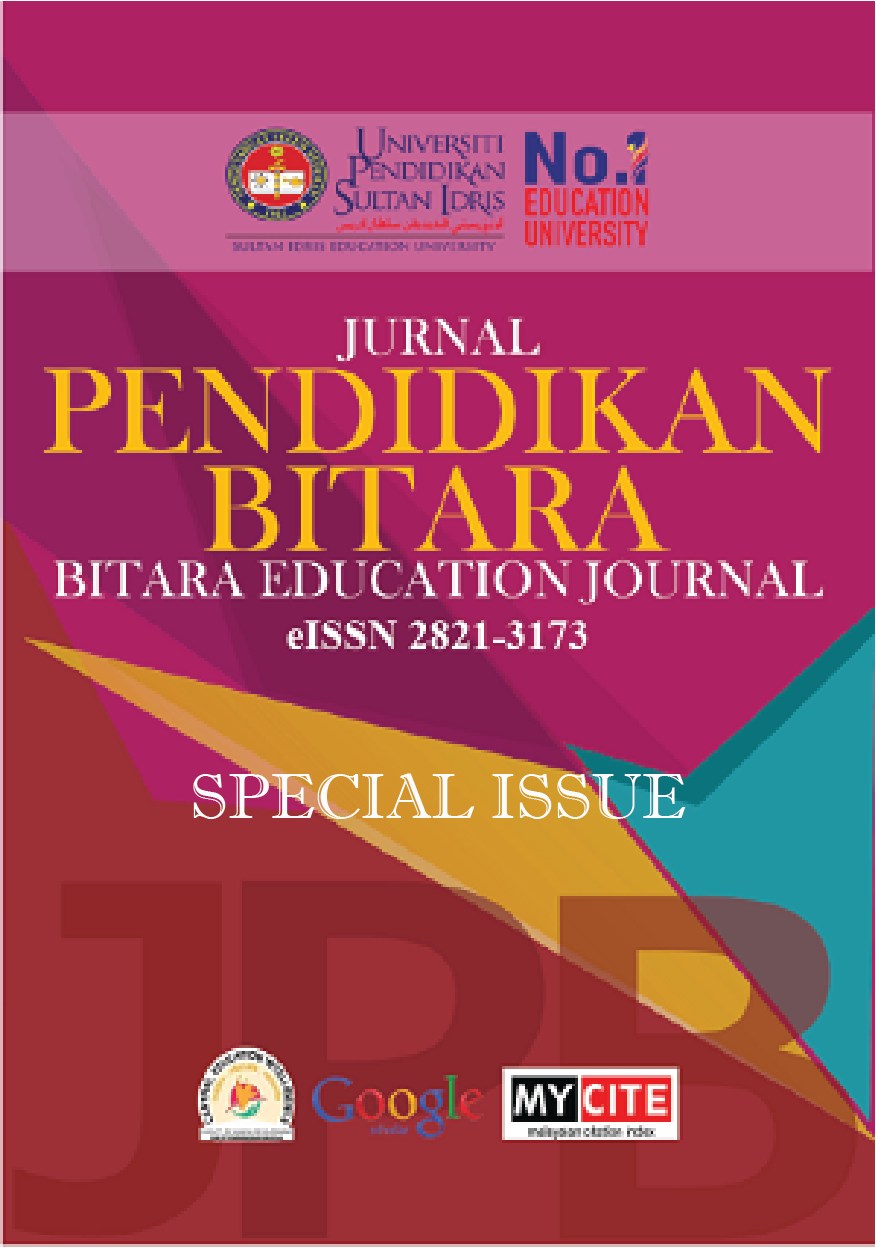Teacher-Centered Strategies in Student Learning: A Case Study for Student Transition at Genius Kurnia
DOI:
https://doi.org/10.37134/bitara.vol14.sp2.9.2021Keywords:
Autism, Teacher-centered strategies, Student learning, Inclusive program, Special need education, Early intervention, Child readinessAbstract
Inclusion defined as having a full and active part in the life of the mainstream kindergarten or school. The curriculum may be necessary to promote shared learning experiences and social interaction between children with and without disabilities. Children with disabilities need to have readiness to be in an inclusion classroom. Therefore, the purpose of this study was to identify the readiness of the transition class students at GENIUS Kurnia by using a teacher-centered strategy as an intervention. These children need to have the readiness to attend an inclusive education program. Readiness in this study was identified based on 4 domains: attention, problem-solving, language and communication, socio-emotional and behavioral during learning. A case study had been conducted to 7 students at GENIUS Kurnia’s transition class that meet the following criteria: the students have attended at least 3 months in the transition class, are able to follow 6 to 10 routine instructions independently, able to sit at a desk for more than 10 minutes independently, showed minimal challenging behaviors and possess skills in pre-academic learning. Instrument Senarai Semak Kesediaan Inklusif Murid Berkeperluan Khas adapted from Garis Panduan Program Pendidikan Inklusif Murid Berkeperluan Khas Kementerian Pendidikan Malaysia, 2018. 24 items were used in this study together with observations and anecdotal records. Based on the findings, the study samples showed high readiness in the domains of attention and problem solving. A moderate readiness was observed in the language and communication domain as well as the socio- emotional and behavioral domain. In conclusion, teacher-centered strategies used for student transitions at GENIUS Kurnia Centre are proven adaptable. It can be used as a reference for future research topics about learning strategies for special needs students in preparation for the Inclusive Education Program in schools. However, the limitation of this study was the small samples of autism kids with not challenging behavior and already having their early intervention at GENIUS Kurnia for more than a year.
Downloads
References
American Psychiatric Association. (2013). Diagnostic and statistical manual of mental disorders (DSM-5®). American Psychiatric Pub.
Andrews, D., Walton, E., & Osman, R. (2019). Constraints to the implementation of inclusive teaching: a cultural historical activity theory approach. International journal of inclusive education, 1-16.
Banire, B., Al Thani, D., Qaraqe, M., Mansoor, B., & Makki, M. (2020). Impact of mainstream classroom setting on attention of children with autism spectrum disorder: An eye-tracking study. Universal Access in the Information Society, 1-11.
Bury, S. M., Jellett, R., Spoor, J. R., & Hedley, D. (2020). “It defines who I am” or “It’s something I have”: What language do [autistic] Australian adults [on the autism spectrum] prefer?. Journal of autism and developmental disorders, 1-11.
Chen, N., Miller, S., Milbourn, B., Black, M. H., Fordyce, K., Van Der Watt, G. & Girdler, S. (2020). “The big wide world of school”: Supporting children on the autism spectrum to successfully transition to primary school: Perspectives from parents and early intervention professionals. Scandinavian Journal of Child and Adolescent Psychiatry and Psychology, 8, 91-100.
Dervić, D., Glamočić, D. S., Gazibegović-Busuladžić, A., & Mešić, V. (2018). Teaching physics with simulations: Teacher-centered versus student-centered approaches. Journal of Baltic Science Education, 17(2), 288
Emaliana, I. (2017). Teacher-centered or student-centered learning approach to promote learning?.Jurnal Sosial Humaniora (JSH), 10(2), 59-70.
Hellblom-Thibblin, T. (2018). Challenges and dilemmas–a conceptual approach to children’s diversity in school. European journal of special needs education, 33(1), 1-15.
Kamaralzaman, S. (2019). Parents Satisfaction with Early Intervention Programme in GENIUS Kurnia. In 3rd International Conference on Special Education (ICSE 2019) (pp. 169-172). Atlantis Press.
Larcombe, T. J., Joosten, A. V., Cordier, R., & Vaz, S. (2019). Preparing Children with Autism for Transition to Mainstream School and Perspectives on Supporting Positive School Experiences. Journal of Autism and Developmental Disorders. Doi: 10.1007/s10803-019- 04022-z.
Malaysia, K. P. (2013). Pelan pembangunan pendidikan Malaysia 2013-2025. Putrajaya: Kementerian Pendidikan Malaysia.
Malaysia, K. P. (2018). Garis Panduan Program Pendidikan Inklusif Murid Berkeperluan Khas.Putrajaya: Bahagian Pendidikan Khas, KPM.
Molbaek, M. (2018). Inclusive teaching strategies–dimensions and agendas. International Journal of Inclusive Education, 22(10), 1048-1061.
Nunes, A. K. F., Barroso, R. D. C. A., & Santos, J. F. (2019, October). The use of Triangulation as a tool for validation of data in qualitative research in Education. In World Conference on Qualitative Research (Vol. 1, pp. 334-336).
Qvortrup, A., & Qvortrup, L. (2018). Inclusion: Dimensions of inclusion in education. International Journal of Inclusive Education, 22(7), 803-817.
Rojas-Torres, L. P., Alonso-Esteban, Y., & Alcantud-Marín, F. (2020). Early Intervention with Parents of Children with Autism Spectrum Disorders: A Review of Programs. Children, 7(12), 294.
Salceanu, C. (2020). Development and Inclusion of Autistic Children in Public Schools. BRAIN. Broad Research in Artificial Intelligence and Neuroscience, 11(1), 14-31.
Sasson, N. J., Faso, D. J., Nugent, J., Lovell, S., Kennedy, D. P., & Grossman, R. B. (2017). Neurotypical peers are less willing to interact with those with autism based on thin slice judgments. Scientific reports, 7(1), 1-10.
Serin, H. (2018). A comparison of teacher-centered and student-centered approaches in educational settings. International Journal of Social Sciences & Educational Studies, 5(1), 164-167.
Sokal, L., & Sharma, U. (2017). Do I really need a course to learn to teach students with disabilities? I’ve been doing it for years. Canadian Journal of Education/Revue canadienne de l'éducation, 40(4), 739-760.
Stephenson, J., Browne, L., Carter, M., Clark, T., Costley, D., Martin, J., Sweller, N. (2020).Facilitators and Barriers to Inclusion of Students with Autism Spectrum Disorder: Parent, Teacher, and Principal Perspectives. Australasian Journal of Special and Inclusive Education, 1-17. doi:10.1017/jsi.2020.12
Yakubova, G., & Taber-Doughty, T. (2017). Improving problem-solving performance of students with autism spectrum disorders. Focus on Autism and Other Developmental Disabilities, 32(1), 3-17.





